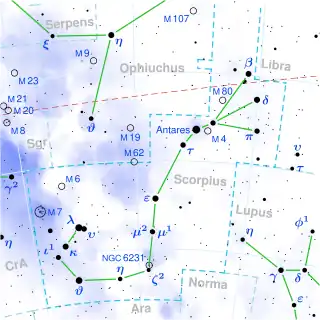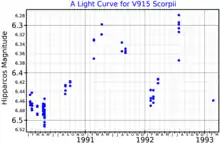 | |
| Observation data Epoch J2000.0 Equinox J2000.0 | |
|---|---|
| Constellation | Scorpius |
| Right ascension | 17h 14m 27.65508s[1] |
| Declination | −39° 45′ 59.9378″[1] |
| Apparent magnitude (V) | 6.22 - 6.64[2] |
| Characteristics | |
| Spectral type | K0Ia-0[3] |
| U−B color index | 2.48[4] |
| B−V color index | 2.25[4] |
| Variable type | Unknown[2] |
| Astrometry | |
| Radial velocity (Rv) | 46.00[5] km/s |
| Proper motion (μ) | RA: −0.758[1] mas/yr Dec.: −1.466[1] mas/yr |
| Parallax (π) | 0.5485 ± 0.0525 mas[1] |
| Distance | 5,900 ± 600 ly (1,800 ± 200 pc) |
| Absolute magnitude (MV) | −9.0[6] |
| Details | |
| Mass | 6.1[7] M☉ |
| Radius | 571[8] R☉ |
| Luminosity | 74,000[9] L☉ |
| Surface gravity (log g) | 0.01[7] cgs |
| Temperature | 3,990[9] K |
| Metallicity [Fe/H] | −0.21[7] dex |
| Other designations | |
| Database references | |
| SIMBAD | data |
V915 Scorpii (HR 6392, HD 155603) is an orange hypergiant variable star in the constellation Scorpius.
Surroundings

V915 Scorpii is surrounded by the sparse OB association Moffat 2.[10] It is also surrounded by an envelope of dust and gas, producing a significant infrared excess.[11]
V915 Sco has been classified as a triple star. 15" away is the Wolf-Rayet star WR 85, one of the most luminous stars known, but still visually four magnitudes fainter than V915 Sco.[12] Component C is a 10th magnitude K class star 17" away.[13] There is also a 14th magnitude star 22" away. Photometry and space motions suggest that only V915 Sco and WR 85 lie at the same distance, while the other two stars are foreground objects. Assumptions about the brightness of each star suggest a distance of 2,600 pc, and a projected separation of 0.2 pc.[14]
Four arc minutes distant are two other assumed members of the association, a 10th magnitude B0 giant and an 11th magnitude OB star. Fitting the association members to a main sequence gives a highly uncertain distance of 1.8 kpc.[10] A kinematical distance has been calculated for the bubble around WR 85 at 2.8 kpc.[15] The distance to V915 Scorpii derived assuming minimal interstellar extinction is 7,300 pc.[11] However, the star is considerably reddened and this results in a distance of 2,630 pc.[14] Analysis of WR 85 as a luminous hydrogen-rich star gives a distance of 6,600 pc.[12] The Gaia EDR3 parallax of V915 Scorpii implies a distance of around 1,800 pc, although with a significant amount of astrometric noise. The parallax for WR 85 is considerably more reliable and suggests a distance of around 2,400 pc.[16]
Variable

V915 Scorpii is variable over nearly half a magnitude, but the nature of the variations is not known.[2][18] Any period associated with the variation is longer than 600 days.[19]
Properties
The distance to V915 Sco is highly uncertain, and it has hardly been observed in the last 20 years, but its absolute magnitude is consistently determined between −8 and −9, making it an extremely luminous supergiant.[10][6][11] However, some recent publications give a less extreme bolometric luminosity of about 74,000 L☉.[9]
The spectral type of V915 Scorpii was determined to be G5Ia in 1954,[20] G5Ia-0 in 1973,[21] G8Ia in 1977,[10] K0Ia in 1982,[22] and K0Ia-0 in 1989,[3] all indicative of a luminous supergiant or hypergiant.
See also
References
- 1 2 3 4 5 Brown, A. G. A.; et al. (Gaia collaboration) (2021). "Gaia Early Data Release 3: Summary of the contents and survey properties". Astronomy & Astrophysics. 649: A1. arXiv:2012.01533. Bibcode:2021A&A...649A...1G. doi:10.1051/0004-6361/202039657. S2CID 227254300. (Erratum: doi:10.1051/0004-6361/202039657e). Gaia EDR3 record for this source at VizieR.
- 1 2 3 Samus, N. N.; Durlevich, O. V.; et al. (2009). "VizieR Online Data Catalog: General Catalogue of Variable Stars (Samus+ 2007-2013)". VizieR On-line Data Catalog: B/GCVS. Originally Published in: 2009yCat....102025S. 1. Bibcode:2009yCat....102025S.
- 1 2 Keenan, Philip C.; McNeil, Raymond C. (1989). "The Perkins catalog of revised MK types for the cooler stars". Astrophysical Journal Supplement Series. 71: 245. Bibcode:1989ApJS...71..245K. doi:10.1086/191373. S2CID 123149047.
- 1 2 Ducati, J. R. (2002). "VizieR Online Data Catalog: Catalogue of Stellar Photometry in Johnson's 11-color system". CDS/ADC Collection of Electronic Catalogues. 2237: 0. Bibcode:2002yCat.2237....0D.
- ↑ Barbier-Brossat, M.; Petit, M.; Figon, P. (1994). "Third bibliographic catalogue of stellar radial velocities (Text in French)". Astronomy and Astrophysics Supplement Series. 108: 603. Bibcode:1994A&AS..108..603B.
- 1 2 Stickland, D. J. (1985). "IRAS observations of the cool galactic hypergiants". The Observatory. 105: 229. Bibcode:1985Obs...105..229S.
- 1 2 3 Anders, F.; Khalatyan, A.; Chiappini, C.; Queiroz, A. B.; Santiago, B. X.; Jordi, C.; Girardi, L.; Brown, A. G. A.; Matijevič, G.; Monari, G.; Cantat-Gaudin, T.; Weiler, M.; Khan, S.; Miglio, A.; Carrillo, I.; Romero-Gómez, M.; Minchev, I.; De Jong, R. S.; Antoja, T.; Ramos, P.; Steinmetz, M.; Enke, H. (2019). "Photo-astrometric distances, extinctions, and astrophysical parameters for Gaia DR2 stars brighter than G = 18". Astronomy and Astrophysics. 628: A94. arXiv:1904.11302. Bibcode:2019A&A...628A..94A. doi:10.1051/0004-6361/201935765. S2CID 131780028.
- ↑ Stassun, Keivan G.; Oelkers, Ryan J.; Paegert, Martin; Torres, Guillermo; Pepper, Joshua; De Lee, Nathan; Collins, Kevin; Latham, David W.; Muirhead, Philip S.; Chittidi, Jay; Rojas-Ayala, Bárbara (2019-10-01). "The Revised TESS Input Catalog and Candidate Target List". The Astronomical Journal. 158 (4): 138. arXiv:1905.10694. Bibcode:2019AJ....158..138S. doi:10.3847/1538-3881/ab3467. hdl:1721.1/124721. ISSN 0004-6256. S2CID 166227927.
- 1 2 3 Dorn-Wallenstein, Trevor Z.; Levesque, Emily M.; Neugent, Kathryn F.; Davenport, James R. A.; Morris, Brett M.; Gootkin, Keyan (2020). "Short-term Variability of Evolved Massive Stars with TESS. II. A New Class of Cool, Pulsating Supergiants". The Astrophysical Journal. 902 (1): 24. arXiv:2008.11723. Bibcode:2020ApJ...902...24D. doi:10.3847/1538-4357/abb318. S2CID 221340538.
- 1 2 3 4 Moffat, A. F. J.; Fitzgerald, M. P. (1977). "Some very luminous supergiants associated with compact groups of luminous OB stars". Astronomy and Astrophysics. 54: 263. Bibcode:1977A&A....54..263M.
- 1 2 3 Odenwald, S. F. (1986). "An IRAS survey of IR excesses in G-type stars". Astrophysical Journal. 307: 711. Bibcode:1986ApJ...307..711O. doi:10.1086/164456.
- 1 2 Hamann, W.-R.; Gräfener, G.; Liermann, A. (2006). "The Galactic WN stars. Spectral analyses with line-blanketed model atmospheres versus stellar evolution models with and without rotation". Astronomy and Astrophysics. 457 (3): 1015. arXiv:astro-ph/0608078. Bibcode:2006A&A...457.1015H. doi:10.1051/0004-6361:20065052. S2CID 18714731.
- ↑ Mason, Brian D.; Wycoff, Gary L.; Hartkopf, William I.; Douglass, Geoffrey G.; Worley, Charles E. (2001). "The 2001 US Naval Observatory Double Star CD-ROM. I. The Washington Double Star Catalog". The Astronomical Journal. 122 (6): 3466. Bibcode:2001AJ....122.3466M. doi:10.1086/323920.
- 1 2 Andrews, J. P. (1977). "HR 6392 - A double star with very high luminosities". Monthly Notices of the Royal Astronomical Society. 178 (2): 131–136. Bibcode:1977MNRAS.178..131A. doi:10.1093/mnras/178.2.131.
- ↑ Vasquez, J.; Cappa, C.; McClure-Griffiths, N. M. (2005). "An HI interstellar bubble surrounding WR85 and RCW118". Monthly Notices of the Royal Astronomical Society. 362 (2): 681–688. arXiv:astro-ph/0507481. Bibcode:2005MNRAS.362..681V. doi:10.1111/j.1365-2966.2005.09349.x. S2CID 16064834.
- ↑ Brown, A. G. A.; et al. (Gaia collaboration) (2021). "Gaia Early Data Release 3: Summary of the contents and survey properties". Astronomy & Astrophysics. 649: A1. arXiv:2012.01533. Bibcode:2021A&A...649A...1G. doi:10.1051/0004-6361/202039657. S2CID 227254300. (Erratum: doi:10.1051/0004-6361/202039657e). Gaia EDR3 record for this source at VizieR.
- ↑ "Hipparcos Tools Interactive Data Access". Hipparcos. ESA. Retrieved 8 December 2021.
- ↑ Dean, J. F. (1980). "BVRI Photometry of the Superluminous Supergiants HR 5171 and HR 6392". Information Bulletin on Variable Stars. 1796: 1. Bibcode:1980IBVS.1796....1D.
- ↑ ESA (1997). "The HIPPARCOS and TYCHO catalogues. Astrometric and photometric star catalogues derived from the ESA HIPPARCOS Space Astrometry Mission". The Hipparcos and Tycho Catalogues. Astrometric and Photometric Star Catalogues Derived from the ESA Hipparcos Space Astrometry Mission. 1200. Bibcode:1997ESASP1200.....E.
- ↑ Bidelman, William P. (1954). "Spectral Classification of Southern Stars of High Luminosity". Publications of the Astronomical Society of the Pacific. 66 (392): 249. Bibcode:1954PASP...66..249B. doi:10.1086/126709.
- ↑ Warren, P. R. (1973). "A model atmosphere analysis of the super-supergiant HR 5171". Monthly Notices of the Royal Astronomical Society. 161 (4): 427–444. Bibcode:1973MNRAS.161..427W. doi:10.1093/mnras/161.4.427.
- ↑ Houk, N. (1982). "Michigan Catalogue of Two-dimensional Spectral Types for the HD stars. Volume_3. Declinations -40_ƒ0 to -26_ƒ0". Michigan Catalogue of Two-dimensional Spectral Types for the HD stars. Volume_3. Declinations -40_ƒ0 to -26_ƒ0. Bibcode:1982mcts.book.....H.